Samsung recently launched its Galaxy S25 series, which used the Snapdragon 8 Elite SoC. It replaced the Exynos 2400 in some regions. Now, reports are coming that Samsung may again use the Exynos chipset in its next Galaxy S26 series. Let’s know the possible features of this new series and what is special about the Exynos 2600.
Exynos 2600 chipset can be found in Galaxy S26 series
Samsung is planning to include the Exynos 2600 chipset in its Galaxy S26 series. According to Korean media outlet The Bell, the company has achieved a yield rate of over 30 percent in 2nm SF2 test production. Yield rate means what percentage of chips out of the total production are fully functional.
Preparations by two main Samsung divisions
Samsung Electronics’ System LSI Division and Foundry Division are both preparing resources for the production of the Exynos 2600. It will be interesting to see if Samsung is able to present its Exynos chipset in a new form this time. If everything goes as planned, Samsung may start mass production of the Exynos 2600 in the fourth quarter of the year.
Galaxy S26 Series Features
Processor: Exynos 2600 (2nm technology)
Yield rate: More than 30% (SF2 test production)
Camera: 200MP periscope telephoto lens (expected)
Display: Under-display camera, better resolution
Launch date: Early next year
Other features: Under-display sensor, fast charging
The journey from Exynos 2500 to Exynos 2600
In mid-2024, reports said that the Exynos 2500 had a yield of only 20 percent. Because of this, Samsung used Snapdragon chips in all variants of the Galaxy S25 series. But now the yield rate of the 2nm Exynos 2600 has seen improvement. If this continues, the return of Exynos in the Galaxy S26 series is considered certain.
Possible features of Galaxy S26 Ultra
The Samsung Galaxy S26 Ultra is likely to get an under-display camera sensor and better display upgrades. Apart from this, Samsung is also considering adding a 200MP 1/1.4-inch periscope telephoto lens, which could add a new dimension to photography.
